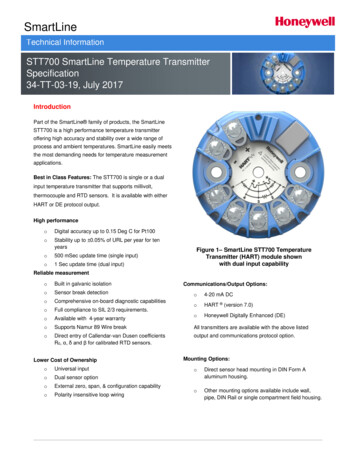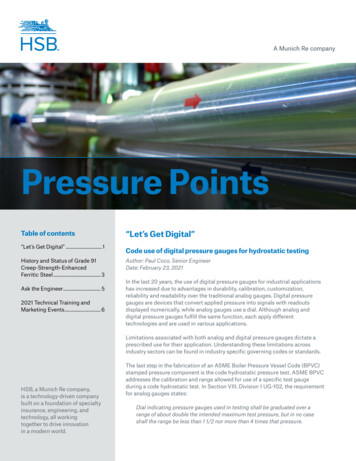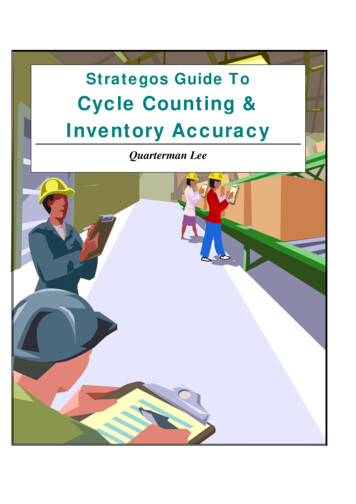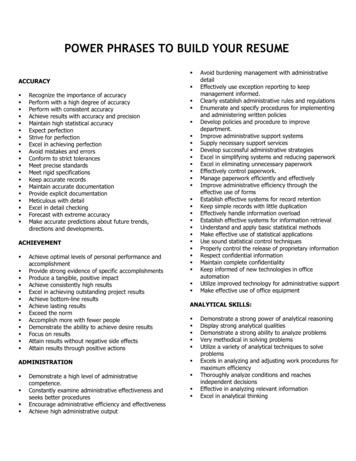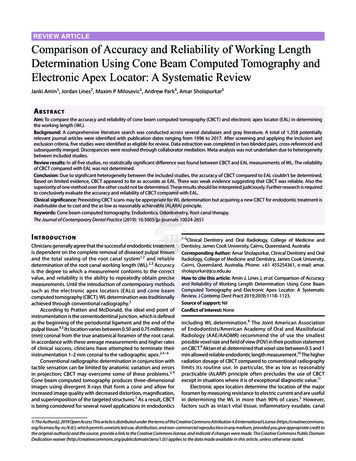
Transcription
REVIEW ARTICLEComparison of Accuracy and Reliability of Working LengthDetermination Using Cone Beam Computed Tomography andElectronic Apex Locator: A Systematic ReviewJanki Amin1, Jordan Lines2, Maxim P Milosevic3, Andrew Park4, Amar Sholapurkar5A b s t r ac tAim: To compare the accuracy and reliability of cone beam computed tomography (CBCT) and electronic apex locator (EAL) in determiningthe working length (WL).Background: A comprehensive literature search was conducted across several databases and gray literature. A total of 1,358 potentiallyrelevant journal articles were identified with publication dates ranging from 1996 to 2017. After screening and applying the inclusion andexclusion criteria, five studies were identified as eligible for review. Data extraction was completed in two blinded pairs, cross-referenced andsubsequently merged. Discrepancies were resolved through collaborator mediation. Meta-analysis was not undertaken due to heterogeneitybetween included studies.Review results: In all five studies, no statistically significant difference was found between CBCT and EAL measurements of WL. The reliabilityof CBCT compared with EAL was not determined.Conclusion: Due to significant heterogeneity between the included studies, the accuracy of CBCT compared to EAL couldn’t be determined.Based on limited evidence, CBCT appeared to be as accurate as EAL. There was weak evidence suggesting that CBCT was reliable. Also thesuperiority of one method over the other could not be determined. These results should be interpreted judiciously. Further research is requiredto conclusively evaluate the accuracy and reliability of CBCT compared with EAL.Clinical significance: Preexisting CBCT scans may be appropriate for WL determination but acquiring a new CBCT for endodontic treatment isinadvisable due to cost and the as low as reasonably achievable (ALARA) principle.Keywords: Cone beam computed tomography, Endodontics, Odontometry, Root canal therapy.The Journal of Contemporary Dental Practice (2019): nicians generally agree that the successful endodontic treatmentis dependent on the complete removal of diseased pulpal tissuesand the total sealing of the root canal system1 , 2 and reliabledetermination of the root canal working length (WL).2, 3 Accuracyis the degree to which a measurement conforms to the correctvalue, and reliability is the ability to repeatedly obtain precisemeasurements. Until the introduction of contemporary methodssuch as the electronic apex locators (EALs) and cone beamcomputed tomography (CBCT), WL determination was traditionallyachieved through conventional radiography.3 According to Pratten and McDonald, the ideal end point ofinstrumentation is the cementodentinal junction, which is definedas the beginning of the periodontal ligament and the end of thepulpal tissue.4, 5 Its location varies between 0.50 and 0.75 millimeters(mm) coronal from the true anatomical foramen of the root canal.In accordance with these average measurements and higher ratesof clinical success, clinicians have attempted to terminate theirinstrumentation 1–2 mm coronal to the radiographic apex.2, 4 – 6 Conventional radiographic determination in conjunction withtactile sensation can be limited by anatomic variation and errorsin projection; CBCT may overcome some of these problems. 2 , 4 Cone beam computed tomography produces three-dimensionalimages using divergent X-rays that form a cone and allow forincreased image quality with decreased distortion, magnification,and superimposition of the targeted structures.7 As a result, CBCTis being considered for several novel applications in endodonticsincluding WL determination. 8 The Joint American Associationof Endodontists/American Academy of Oral and MaxillofacialRadiology (AAE/AAOMR) recommend the of use the smallestpossible voxel size and field of view (FOV) in their position statementon CBCT.9 Aktan et al. determined that voxel size between 0.5 and 1mm allowed reliable endodontic length measurement.10 The higherradiation dosage of CBCT compared to conventional radiographylimits its routine use. In particular, the as low as reasonablypracticable (ALARP) principle often precludes the use of CBCTexcept in situations where it is of exceptional diagnostic value.11 Electronic apex locators determine the location of the majorforamen by measuring resistance to electric current and are usefulin determining the WL in more than 90% of cases. 5 However,factors such as intact vital tissue, inflammatory exudate, canal Clinical Dentistry and Oral Radiology, College of Medicine andDentistry, James Cook University, Cairns, Queensland, AustraliaCorresponding Author: Amar Sholapurkar, Clinical Dentistry and OralRadiology, College of Medicine and Dentistry, James Cook University,Cairns, Queensland, Australia, Phone: 61 455254361, e-mail: amar.sholapurkar@jcu.edu.auHow to cite this article: Amin J, Lines J, et al. Comparison of Accuracyand Reliability of Working Length Determination Using Cone BeamComputed Tomography and Electronic Apex Locator: A SystematicReview. J Contemp Dent Pract 2019;20(9):1118–1123.Source of support: NilConflict of interest: None The Author(s). 2019 Open Access This article is distributed under the terms of the Creative Commons Attribution 4.0 International License (https://creativecommons.org/licenses/by-nc/4.0/), which permits unrestricted use, distribution, and non-commercial reproduction in any medium, provided you give appropriate credit tothe original author(s) and the source, provide a link to the Creative Commons license, and indicate if changes were made. The Creative Commons Public DomainDedication waiver ) applies to the data made available in this article, unless otherwise stated.
Working Length Determination by CBCT and EALpatency, metallic restorations, size of apical constriction, andcardiac pacemakers may affect the electrical current of the EAL andconsequently the accuracy and reliability of the readings.5 The purpose of this systematic review was to screen and analyzethe literature comparing CBCT with EAL in order to establish whichis more accurate and reliable in determining the WL of permanentteeth of adults. This review question was developed according tothe population, intervention, comparison, outcome, and studydesign (PICOS) format. To the best of the authors’ knowledge, noprevious attempts have been made to review the available literaturefor this purpose.Review ProperThis review was registered in PROSPERO under number2017:CRD42017056345. The review protocol was published as part ofthe proposal and in accordance with the Preferred Reporting Itemsfor Systematic Review and Meta-Analyses (PRISMA) guidelines. Thisreview was designed to answer the following research question:Which is more accurate and reliable in determining WL, CBCT orEAL?Study Selection CriteriaThe review included in vivo comparative human studies. Ex vivo studies on extracted teeth were excluded due to their lack ofclinical relevance. Case series, case reports, reviews, ideas, editorials,and opinions were excluded. The population was defined aspatients with permanent human teeth, as root canal obturationis infrequently undertaken in primary teeth. Studies on animalswere excluded due to their limited clinical relevance. Patients withvarious pathologies were included as there are several reasons whyteeth may require root canal treatment (RCT).12 The interventionswere defined as measurements taken with EAL and CBCT, andonly articles that compared both were included. The outcomeswere defined as accuracy and reliability of measurements. Norestrictions were set on how these outcomes were quantified.Due to the variability in outcome measurements, meta-analysiswas not feasible. No studies were excluded based on differencesin time between intervention and outcome measurements acrossstudies. No limitations were applied based on the study location,language, or sample size.Information SourcesSearch terms were developed using medical subject headingsand words related to CBCT, EAL, and WL. An electronic search wasundertaken in the databases, including PubMed (NCBI interface,1946 onward), ProQuest (Health and Medicine Collection, 1946onward), CINAHL (EBSCO-host interface, 1999 onward), MEDLINE(OvidSP interface, 1946 onward), Science Direct (Elsevier interface,1946 onward), Scopus (Elsevier interface, 1946 onward), and Web ofScience (Thomson Reuters interface, 1965 onward). Gray literaturedatabases including TROVE, Worldcat, Google Scholar, and AHRQwere searched without publication date restrictions. The date ofthe last search was July 11, 2017.Search StrategyPROSPERO was searched for ongoing or completed systematicreviews on this topic to ensure the necessity and relevance of thisreview. Databases were searched using the James Cook Universityregistry. One author developed the Medline search strategy, whichwas then peer reviewed by the remaining authors and a librarianwith experience in systematic review search strategies. This wassubsequently adapted to the syntax and subject headings of theother databases, including gray literature databases. Finally, thereviewers manually searched the reference lists of eligible articlesfor additional relevant citations. Search results were uploaded toEndNote X8, and duplicates were deleted. Training in this programwas undertaken beforehand. The program allowed review authorsto collaborate and be blinded to the other authors’ decisions, whennecessary.Study Selection, Data Extraction, and AnalysisThe search results were screened systematically to reduce thechance of excluding relevant studies. The inclusion and exclusioncriteria were clarified between four authors. Title screening wascompleted by two pairs of authors and discrepancies reviewed withboth pairs present. Abstract screening was carried out individuallyby three authors and discrepancies were resolved by the fourthauthor. Full-text screening was completed in pairs and a decisionwas made as to whether the studies met the criteria. Disagreementswere resolved through discussion, and reasons for exclusion wererecorded. No review authors were blinded to journal titles, studyauthors, or institutions. All authors were blinded to the other pair’sor individual author’s decisions until arbitration.Using a standardized, preformatted form, data were extractedfrom each eligible study in pairs. To ensure consistency, all fourreviewers undertook a calibration process prior to data extraction.Sample characteristics, methodology, intervention details, andall reported outcomes regarding the interventions of relevancewere included in data extraction. The independently completedduplicate forms were merged and compared for inconsistencies,which were resolved by discussion between all authors. Anyunresolved disagreements were arbitrated by a collaborator withexperience in dental radiology and research.Some eligible studies evaluated additional techniques for WLdetermination, such as intraoral periapical (IOPA).13, 14 However, onlydata relevant to the research question were extracted. Differencesbetween the variety of EAL and CBCT systems used by eligiblestudies were not considered in this review.Evaluation of accuracy was determined by the agreementbetween CBCT and EAL measurements. Reliability was quantifiedthrough assessment of differences between repeat measurements.A variety of statistical methods were employed across all studiesin outcome measurement. Both accuracy and reliability wereconsidered with equal priority, and no secondary outcomes wereconsidered.Risk of Bias in Individual StudiesThe risk of bias in individual studies was assessed using a modifiedversion of the criteria proposed by Hadorn et al.15 These criteria wereadapted to facilitate bias assessment for the experimental designsincluded in the review. Using the extracted data, studies werescreened for major and minor flaws independently by two pairs ofauthors. To reach agreement, pairs discussed any inconsistenciesbetween assessments. Arbitration by the collaborator was soughtwhen this failed. Three minor flaws were equal to one major flaw,allowing the generation of a score of bias for each study. Based onthe scores, studies were divided into three levels of evidence. LevelI comprised well-conducted studies. Level II comprised moderatelywell-conducted studies with some flaws, while level III comprisedstudies with significant flaws affecting their validity and reliability.The Journal of Contemporary Dental Practice, Volume 20 Issue 9 (September 2019)1119
Working Length Determination by CBCT and EALR e v i e w R e s u ltsThe initial search from the databases produced 4,361 articles,with an additional 55 articles sourced from gray literature. Afterduplicates were removed, 1,358 articles remained. Of these studies,all but 129 were excluded based on titles. Six articles met theinclusion criteria upon abstract screening. On full-text assessment,one study was excluded as it did not include CBCT as a methodof measurement and thus failed to meet the inclusion criteria.16 Reference lists from the eligible articles were manually searchedwith no additional relevant studies found. A total of five studieswere selected (Flowchart 1).Study CharacteristicsPublication years ranged from 2011 to 2016 (Table 1). The brandsand models of the CBCT and EAL varied depending on the study.Equipment operators were appropriately trained within the fieldsof dental radiology and endodontics.Risk of BiasOf the five included studies, two were found to be well-conductedwith minimal risk of bias,17, 18 and three studies were moderatelywell-conducted with some flaws affecting study validity andreliability13, 14, 19 (Table 2).Results of Individual StudiesIn all five studies, no significant difference was found betweenmeasurements taken with CBCT and EAL (Table 3).13, 14, 17– 19 Threestudies evaluated the reliability of CBCT, finding it to be reliablebased on Pearson correlation coefficient calculations of repeatedmeasurements.17– 19 No studies evaluated the reliability of EAL,thus it could not be compared with CBCT in this context. Dueto their comparative nature, no studies favored one methodfor accuracy of WL determination over another. Rather, eachstudy confirmed that CBCT is at least as accurate as EAL in WLdetermination.DiscussionAccurate WL determination is required to achieve total removalof the pulpal tissue and complete sealing of the canals, ensuringsuccessful endodontic outcomes for the patient.1, 2 Currently, EALwith adjunctive IOPA radiography is the preferred method of WLdetermination.4 This systematic review was conducted to assesswhether CBCT is able to determine WL more accurately and reliablythan EAL based on the current literature. Overall, there was a lackof evidence and a lack of high-quality evidence. As such, it was notpossible to conclude which measurement technique was moreaccurate or reliable.All included studies demonstrated that measurements basedon CBCT were not significantly different to those taken withEAL.13, 14, 17– 19 As electronic measurements are currently considereda clinically acceptable means of determining WL,5 these findingssuggested that CBCT is at least as accurate as EAL. The clinicalaccuracy of either method cannot be established.In most cases, the WL will have been already determined priorto the prescription of CBCT. However, the authors of four studiessuggested that CBCT may be used for WL determination when thereis a preexisting CBCT scan available.14, 17– 19 Acquiring a new CBCTspecifically for endodontic treatment is not advised due to costsand the high level of radiation exposure to the patient.13, 14 Ustunet al. suggested that prior to using a preexisting CBCT, cliniciansshould ensure that there have been no pathological changes. Forexample, external root resorption may result in a change to thereference point, root or root canal length.18 The eligible studies elicited less evidence for reliability whencompared to accuracy. Studies by Jeger et al., Janner et al., andUstun et al. suggested that CBCT was reliable but did not considerFlowchart 1: PRISMA flowchart1120The Journal of Contemporary Dental Practice, Volume 20 Issue 9 (September 2019)
TurkeyUstun et al.,2016QR Verona ItalyJ. Morita USAAnterior and posteriorsingle canal teeth30/73/73m–M–Selection of samples–Mm–mM mm–mAllocation of samples to Measurementintervention groupsusedmm––––Study administration–––––M, major flaw present; m, minor flaw present; –, no flaw present; III, level of evidence 3; II, level of evidence 2; I, level of evidence 1Study type/authors, yearIn vivo de Morais et al,2016Eslinger, 2012Janner et al., 2011Jeger et al., 2012Ustun et al., 2016Table 2: Risk of bias within studiesWithdrawals fromthe studym––––MMMMStatisticalanalysisM mIIIIIILevel ofevidenceIICBCT measurements of WL were repeatedonce and correlation with previous resultsmeasuredCBCT measurements were repeated after1 week to calculate an intraoperatorreliability coefficientCBCT images were evaluated by a singleexpert radiologist twice and theintraoperator reliability was evaluatedusing the Pearson correlation coefficientNoneMethod of reliability measurementNoneOutcome measurementand blinding–Median values for CBCT, Raypex 6,and Propex Pixi measurements werecomparedSample sizePatients/teeth/canalsMethod of accuracy measurement19/30/30The mean values of WL obtained withEAL, IOPA radiographs, and CBCTimages were comparedAnterior and posterior, nd/14/40Paired sample t tests were conductedwith measurements from coronal andunspecified number ofsagittal CBCT images and comparedcanalsto EAL measurementsAnterior and posterior, 3/9/10The Pearson correlation coefficientvarying number ofwas used to compare EAL with CBCTcanalsvalues to evaluate agreementAnterior, single canal30/40/40Correlation between EAL and CBCTteethCharacteristics of teethincludedAnterior, single canalteethCBCT, cone beam computed tomography; EAL, electronic apex locator; nd, not described; IOPA, intraoral periapicalDentsply,VDWJ. Morita USASwitzerlandJeger et al.,2012Morita JapanCareStreamHealth Inc.J. Morita USAJ. MoritaJapanCBCT brandICATEAL brandJ. Morita USAJanner et al., Switzerland2011Study type/authors, year CountryIn vivo deBrazilMorais et al.,2016Eslinger,USA2012Table 1: Study characteristicsWorking Length Determination by CBCT and EALThe Journal of Contemporary Dental Practice, Volume 20 Issue 9 (September 2019)1121
Working Length Determination by CBCT and EALTable 3: ResultsStudy type/authors, yearIn vivos de Morais et al., 2016Eslinger, 2012Janner et al., 2011Jeger et al., 2012Ustun et al., 2016AccuracyNo difference (p 0.05)No difference (p 0.05)No difference (PCC 0.968)No difference, mean discrepancy betweenCBCT and EAL was 0.51 mm (CI 95%)No difference (p 0.05)ReliabilityN/AN/ARepeated CBCT measurements were reliable (PCC 0.998)Repeated CBCT measurements were reliable (PCC 0.99)Repeated CBCT measurements were reliable (PCC 0.96)CBCT, cone beam computed tomography; EAL, electronic apex locator; PCC, Pearson correlation coefficient; CI, confidence interval; N/A, not applicableEAL reliability.17– 19 Existing literature and the widespread clinicalapplication of EAL suggests that it is reliable; however, this cannotbe confirmed within the boundaries of this review.20 No definitiveconclusion can be drawn with respect to which method is morereliable.L i m i tat i o n sAll studies included in this review had various flaws affecting theirvalidity and reliability. Being in vivo in design, the included studiescould not elicit the superiority of one measurement technique,despite their greater clinical relevance. All studies were likelyunderpowered due to small sample sizes and thus susceptible totype II error.21 Therefore, the failure of all eligible studies to detecta significant difference between measurement methods should beinterpreted with caution.13, 14, 17– 19 All studies were assessed to be either well-conducted ormoderately well-conducted with some flaws. As seen in Table 2,all studies had major inadequacies in their statistical analysis. Allstudies used the correlation coefficient to compare CBCT and EAL.However, differences between clinical measurement methodsare more appropriately evaluated using a Bland–Altman plot. 22 Sample selection was generally well-described; however, twostudies were assigned at least one major or minor flaw for sampleselection.13, 17 Three of the study protocols failed to randomize theorder of measurement methods.14, 18, 19 The effect of this is unknownbut may have increased bias. Jeger et al. was the only study tocomprehensively describe CBCT, EAL, and repeat measurementtechniques.17 Three studies described repeated measurements,enhancing data reliability.17– 19 The primary limitation of this review was its comparison ofstudies with variable sample sizes, equipment brands, inclusioncriteria, and outcome measurement methods. Furthermore, variousCBCT slices were used to obtain WL, reducing the inter-studycomparability. Additionally, three studies failed to specify voxelsize, potentially resulting in different spatial resolutions acrossstudies. This review was restricted to comparing the accuracy andreliability of CBCT and EAL. As such, other, potentially more accuratemethods of WL determination such as conventional radiographywere not considered.The accuracy and reliability of CBCT WL determination demandsfurther enquiry. It is recommended that prospective researcherscomplete a power analysis to acquire an adequate sample size.Further research is required to evaluate the clinical utility of CBCTin WL determination. Future studies would also benefit frominvestigation into voxel size, jaw type, tooth type, canal number,and morphology and their effects on WL measurement.It may also be beneficial to compare the outcomes of RCTbased on the method of WL determination used. Teeth thathave undergone occlusal shortening after the CBCT scan also1122require investigation, as this may alter the reference point and inturn affect WL.17 It is also recommended that teeth with metallicrestorations are studied in detail to determine the most effectivemethod of establishing their WL. Metallic restorations can reducethe accuracy of CBCT through scatter and EAL through electricalshort-circuiting.13, 18 Finally, a combined in vivo and ex vivo study on patients withpreexisting CBCTs would be beneficial. This could involve measuringWL in vivo using CBCT and EAL, extracting the hopeless tooth andestablishing actual WL ex vivo . While such a study would requireethical consideration, it would allow actual WL to be measured asthe control for accuracy and reliability comparisons.C o n c lu s i o nDue to significant heterogeneity between the included studies, theaccuracy of CBCT compared to EAL in WL determination could notbe determined. However, based on the limited evidence available,CBCT appeared to be at least as accurate as EAL in determiningWL. Consequently, WL determination using a preexisting CBCTscan may be a clinically appropriate method.14, 17– 19 Despite this,there was inadequate evidence to justify acquisition of a newCBCT specifically for endodontic treatment due to cost andradiation exposure.16 While preexisting scans are beneficial forWL determination, the ALARP principle should guide referral fornew CBCT acquisition. There was a lack of high-level evidencecomparing the reliability of CBCT with EAL. However, the eligiblestudies generally suggested that CBCT was reliable. These resultsshould be interpreted judiciously. Further research is requiredto conclusively evaluate the accuracy and reliability of CBCTcompared with EAL.References1. Fleming CH, Litaker MS, et al. Comparison of Classic EndodonticTechniques versus Contemporary Techniques on EndodonticTreatment Success. J Endod 2010;36:414–418. DOI: 10.1016/j.joen.2009.11.013.2. Kqiku L, Städtler P. Radiographic versus electronic root canal workinglength determination. Indian J Dent Res 2011;22(6):777–780. DOI:10.4103/0970-9290.94666.3. Ounsi HF, Naaman A. In vitro evaluation of the reliability of the RootZX electronic apex locator. Int Endod J 1999;32(2):120–123. DOI:10.1046/j.1365-2591.1999.00202.x.4. Pratten DH, McDonald NJ. Comparison of radiographic and electronicworking lengths. J Endod 1996;22(4):173–176. DOI: 10.1016/S00992399(96)80095-1.5. Gordon MPJ, Chandler NP. Electronic apex locators. Int Endod J2004;37(7):425–437. DOI: 10.1111/j.1365-2591.2004.00835.x.6. Sjögren U. Factors affecting the long‐term results of endodontictreatment. J Endod 1990;16:498–504. DOI: 10.1016/S0099 2399(07)80180-4.The Journal of Contemporary Dental Practice, Volume 20 Issue 9 (September 2019)
Working Length Determination by CBCT and EAL7. Kapila S, Conley RS, et al. The current status of cone beam computedtomography imaging in orthodontics. Dentomaxillofac Radiol2011;40(1):24–34. DOI: 10.1259/dmfr/12615645.8. Hoer D, Attin T. The accuracy of electronic working lengthdetermination. Int Endod J 2004;37(2):125–131. DOI: 10.1111/j.01432885.2004.00764.x.9. AAE and AAOMR Joint Position Statement: Use of Cone BeamComputed Tomography in Endodontics 2015 Update. Oral SurgOral Med Oral Pathol Oral Radiol 2015;120(4):508–512. DOI: 10.1016/j.oooo.2015.07.033.10. Aktan AM, Yildirim C, et al. Effects of voxel size and resolution onthe accuracy of endodontic length measurement using cone beamcomputed tomography. Annals of anatomy Anatomischer Anzeiger:official organ of the Anatomische Gesellschaft 2016;208:96–102. DOI:10.1016/j.aanat.2016.05.005.11. Patel S, Durack C, et al. European Society of Endodontologyposition statement: The use of CBCT in Endodontics. Int Endod J2014;47(6):502–504. DOI: 10.1111/iej.12267.12. Lee AHC, Cheung GSP, et al. Long-term outcome of primary nonsurgical root canal treatment. Clin Oral Investig 2012;16(6):1607–1617.DOI: 10.1007/s00784-011-0664-2.13. Eslinger BT. Accuracy of Cone-Beam Computed Tomography (CBCT)in Determining Root Canal Working Length. Chicago, IL: Universityof Illinois; 2012.14. de Morais ALG, de Alencar AHG, et al. Working Length Deter minationUsing Cone-Beam Computed Tomography, Periapical Radiographyand Electronic Apex Locator in Teeth with Apical Periodontitis: AClinical Study. Iran Endod J 2016;11(3):164–168.15. Hadorn DC, Baker D, et al. Rating the quality of evidence for clinicalpractice guidelines. J Clin Epidemiol 1996;49(7):749–754. DOI:10.1016/0895-4356(96)00019-4.16. Connert T, Judenhofer MS, et al. Evaluation of the Accuracy of NineElectronic Apex Locators by Using Micro-CT. Int Endod J 2014;47:698–703. DOI: 10.1111/iej.12206.17. Jeger FB, Janner SF, et al. Endodontic Working Length Measurementwith Preexisting Cone-Beam Computed Tomography Scanning: AProspective, Controlled Clinical Study. J Endod 2012;38(7):884–888.DOI: 10.1016/j.joen.2012.03.024.18. Ustun Y, Aslan T, et al. Evaluation of the Reliability of Cone-beamComputed Tomography Scanning and Electronic Apex LocatorMeasurements in Working Length Determination of Teeth withLarge Periapical Lesions. J Endod 2016;42(9):1334–1337. DOI: 10.1016/j.joen.2016.06.010.19. Janner SF, Jeger FB, et al. Precision of Endodontic Working LengthMeasurements: a Pilot Investigation Comparing Cone-Beam ComputedTomography Scanning with Standard Measurement Techniques.J Endod 2011;37(8):1046–1051. DOI: 10.1016/j.joen.2011.05.005.20. Elayouti A, Dima E, et al. Consistency of Apex Locator Function:A Clinical Study. J Endod 2009;35(2):179–181. DOI: 10.1016/j.joen.2008.10.017.21. Banerjee A, Chitnis UB, et al. Hypothesis testing, type I and typeII errors. Ind Psychiatry J 2009;18(2):127–131. DOI: 10.4103/09726748.62274.22. Bland JM, Altman DG. Statistical methods for assessing agreementbet ween t wo methods of clinical measurement. L ancet1986;1(8476):307–310. DOI: 10.1016/S0140-6736(86)90837-8.The Journal of Contemporary Dental Practice, Volume 20 Issue 9 (September 2019)1123
Determination Using Cone Beam Computed Tomography and . Electronic Apex Locator: A Systematic Review. Janki Amin. 1, Jordan Lines. 2, Maxim P Milosevic. 3, Andrew Park. 4, Amar Sholapurkar. 5. A. bstrAct. Aim: To compare the accuracy and reliability of cone beam computed tomography (CBCT) a





